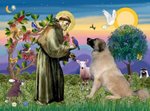 I am currently enrolled in our Graduate Theology program. This term I am taking Foundations of Scripture. Tonight the class had a field trip. We visited the Holy Trinity Greek Orthodox Church. The priest, Father Paul C. Bebis was a gracious, articulate and entertaining teacher.
I am currently enrolled in our Graduate Theology program. This term I am taking Foundations of Scripture. Tonight the class had a field trip. We visited the Holy Trinity Greek Orthodox Church. The priest, Father Paul C. Bebis was a gracious, articulate and entertaining teacher.He welcomed us to his church and immediately began to teach. The area before entering the sanctuary proper represented the darkness of the world. The sanctuary was the Body of Christ. You move from the darkness of this existence into the Body of Christ each time you participate in the liturgy. So what do you do in the dark? You light a candle! Father Bebis taught us how to enter the sanctuary, with candle lighting prayers, venerating the icon, and the proper Orthodox style of praying the sign of the cross.
Once inside the sanctuary he began to teach us about the various icons. The ceiling, walls and sanctuary had beautiful icons of the Mother of God, Jesus, John the Baptist, St. James and St. George. The dome drew your attention upward to more icons.
The Iconostasis, the barrier between the sanctuary and that part of the alter the congregation may approach was simple and yet a powerful border. It symbolizes the boundary between heaven and earth but reminds me of the veil that was the entrance to the Holy of Holies. The male students were able to go through the Iconostasis, using the side entrance only, and view the inner sanctuary.
Father Bebis showed us the lectionary he read from and the rituals he used to prepare the Eucharist. We learned of the two services that take place, the Prothesis or preparation service and the Divine Liturgy or our Mass.
The differences between our two churches were clear. There were Icons in place of statues. Instead of genuflecting there is veneration of the icons. The bread is risen and the body and blood are mixed together and served by a spoon to the celebrants. The service is sung. There is no pope and the priests who are not considering becoming bishops may marry as long as they marry before they are ordained.
For all of the differences the similarities were far stronger. Body of Christ, Eucharist, liturgy, and the value of both ritual and tradition spoke of two churches that are separated by the stubbornness of people. What we share in common is far more important than what divides us. Still, the divisions are not inconsequential and good people can differ and yet respect and even care for one another.
I loved this visit. The priest was a warm, embracing representative of Christ. As we continue to read about the early church I will keep this church in mind as one of the descendants of the early Christians.
Peace and all good.













No comments:
Post a Comment